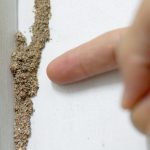Termites in Florida: Identification Guide
Termites have a very special relationship with Florida. Every year, these pests cost home and business owners across the state millions of dollars. There are even a few government funded programs in our state dedicated to tackling this problem, mostly through promoting termite prevention and infestation after care. In most cases, prevention starts with the owner of the property, since they can spot a problem before anyone else can. However, it’s not as easy as it may seem, identifying termites takes a little training. Check out our guide to understanding termites in Florida, so you know what to look for on your property.
Subterranean Termites
The subterranean species of termites come out to play during the spring. The warm temperatures and wet climate trigger these colonies to seek out new sources of food. Their colonies include winged reproductive males and females. They are commonly mistaken for flying ants but have smaller bodies and straight, not bent, antennas. Also, these termites have four wings that are equal in size, while ants have two large wings in the front and two small wings in the back. After mating, subterranean termites shed their wings. If you’ve spotted piles of wings around your home, check to see if they’re the same size. If they are you could have an infestation on your hands.
Subterranean termites typically build their nest underground. Their nesting habits explain why damaged wood typically has soil or dirt accumulation. Also, they only eat softwood, which is why it’s so important to constantly check for water leaks in your home. Wood damaged by subterranean termites look layered because the workers skip over hardwood as they eat. These pests also only eat against the grain.
Picky eaters, right?
Drywood Termites
Drywood termites are also common in the spring time, especially after periods of heavy rain. All Drywood termites shed their wings quickly after swarming. All dead Drywood swarmers are wingless, unlike subterranean termites, who sometimes hold on to their wings. In some cases, Drywood termites are larger than subterranean termites. Drywood workers and soldiers than their subterranean counterparts. Drywood termites have large, wide mandibles with teeth and a
pronotum wider than their head in most cases. These termites need very little moisture to settle in and build a nest for their colony. They are commonly found in attics since no connection to the ground is necessary.
Once a colony is mature, their reproductive termites fly out of their colony to create new ones. Swarms flying in and around your home is a great indicator of Drywood termites in your area. Drywood termites extract water from feces for conservation. They leave behind very distinct fecal pellets called frass. These pellets are hexagonal in shape and are about 1 mm long. Termites push them out of their tunnel, and over time it accumulates. Check for mounds of frass around your property, this is commonly an indication of termite activity.
Contact a Professional Today
Contact a Premier Termite & Pest Control today for an expert inspection. Our team is trained on how to identify termites and knows how to build a plan that works for you.




